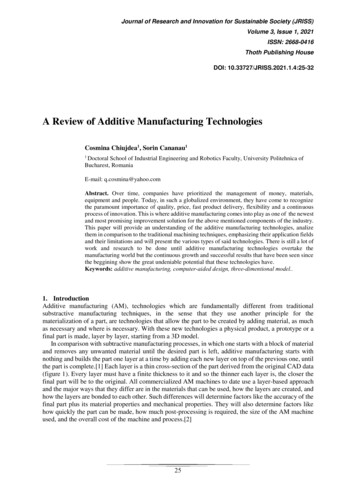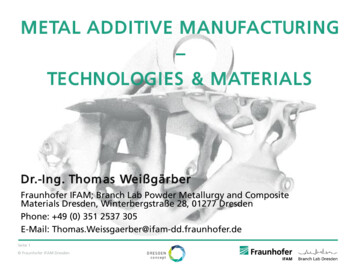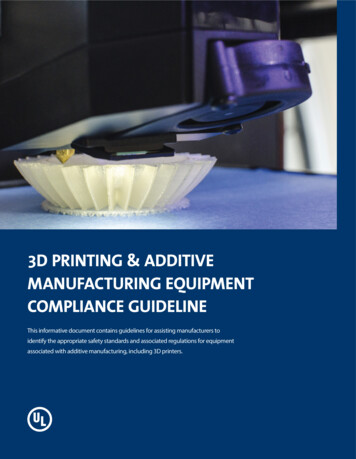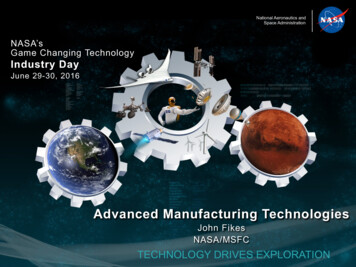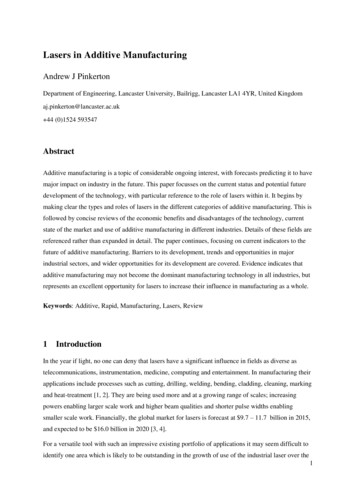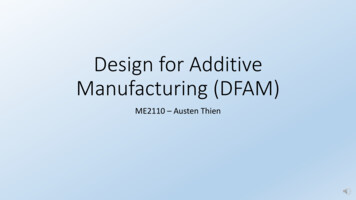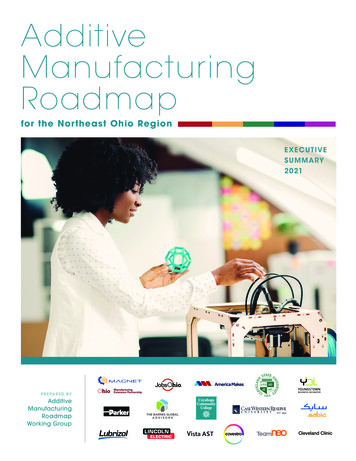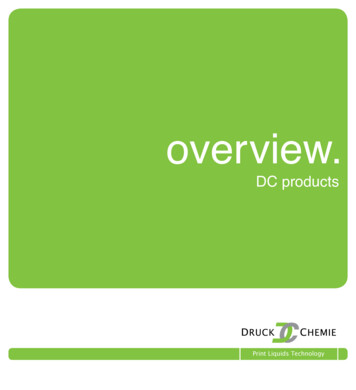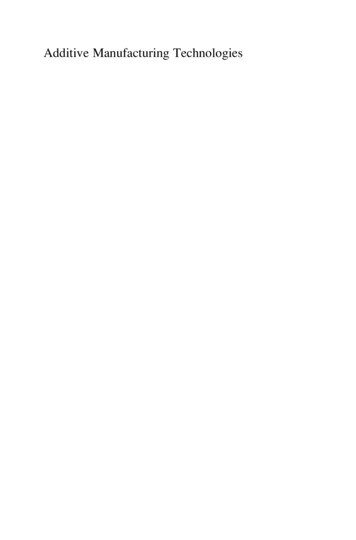
Transcription
Additive Manufacturing Technologies
I. GibsonlD. W. RosenlB. StuckerAdditive ManufacturingTechnologiesRapid Prototyping to Direct DigitalManufacturing
Dr. Ian GibsonDepartment of Mechanical & ProductionEngineeringNational University of Singapore9 Engineering Drive 1Singapore 117576Singaporempegi@nus.edu.sgDr. David W. RosenThe George W. Woodruff School ofMechanical EngineeringGeorgia Institute of Technology813 Ferst Drive, N.W.Atlanta, GA 30332-0405USAdavid.rosen@me.gatech.eduDr. Brent StuckerDepartment of Mechanical &Aerospace EngineeringUtah State University4130 Old Main HallLogan, UT 84322USAbrent.stucker@usu.eduISBN: 978-1-4419-1119-3 e-ISBN: 978-1-4419-1120-9DOI 10.1007/978-1-4419-1120-9Springer New York Heidelberg Dordrecht LondonLibrary of Congress Control Number: 2009934499# Springer ScienceþBusiness Media, LLC 2010All rights reserved. This work may not be translated or copied in whole or in part without the writtenpermission of the publisher (Springer Science Business Media, LLC, 233 Spring Street, New York, NY10013, USA), except for brief excerpts in connection with reviews or scholarly analysis. Use inconnection with any form of information storage and retrieval, electronic adaptation, computersoftware, or by similar or dissimilar methodology now known or hereafter developed is forbidden.The use in this publication of trade names, trademarks, service marks, and similar terms, even if they arenot identified as such, is not to be taken as an expression of opinion as to whether or not they are subjectto proprietary rights.Cover design: The Cover Artwork is Courtesy of Bathsheba Grossman and Bathsheba Sculpture LLCPrinted on acid-free paperSpringer is part of Springer Science Business Media (www.springer.com)
PrefaceThank you for taking the time to read this book on Additive Manufacturing (AM).We hope you benefit from the time and effort it has taken putting it together and thatyou think it was a worthwhile undertaking. It all started as a discussion at aconference in Portugal when we realized that we were putting together bookswith similar aims and objectives. Since we are friends as well as colleagues,it seemed sensible that we join forces rather than compete; sharing the load andplaying to each others’ strengths undoubtedly means a better all-round effort andresult.We wrote this book because we have all been working in the field of AMfor many years. Although none of us like to be called “old,” we do seem to havedecades of experience, collectively, and have each established reputations aseducators and researchers in this field. We have each seen the technologiesdescribed in this book take shape and develop into serious commercial tools, withtens of thousands of users and many millions of parts being made by AM machineseach year. AM is now being incorporated into curricula in many schools, polytechnics and universities around the world. More and more students are becomingaware of these technologies and yet, as we see it, there is no single text adequate forsuch curricula. We hope that now, with this book, there is.Additive Manufacturing is defined by a range of technologies that are capable oftranslating virtual solid model data into physical models in a quick and easyprocess. The data is broken down into a series of 2D cross-sections of a finitethickness. These cross-sections are fed into AM machines so that they can becombined, adding them together in a layer-by-layer sequence to form the physicalpart. The geometry of the part is therefore clearly reproduced in the AM machinewithout having to adjust for manufacturing processes, like attention to tooling,undercuts, draft angles or other features. We can say therefore that the AM machineis a What You See Is What You Build (WYSIWYB) process that is particularlyvaluable the more complex the geometry is. This basic principle drives nearly allAM machines, with variations in each technology in terms of the techniques usedfor creating layers and in bonding them together. Further variations include speed,v
viPrefacelayer thickness, range of materials, accuracy, and of course cost. With so manyvariables, it is clear to see why this book must be so long and detailed. Having saidthat, we still feel there is much more we could have written about.The first three chapters of this book provide a basic overview of AM processes.Without fully describing each technology, we provide an appreciation for why AMis so important to many branches of industry. We outline the rapid development ofthis technology from humble beginnings that showed promise but still requiringmuch development, to one that is now maturing and showing real benefit to productdevelopment organizations. In reading these chapters, we hope you can learn thebasics of how AM works.The next seven chapters (Chaps. 4–10) take each group of technologies in turnand describe them in detail. The fundamentals of each technology are dealt with interms of the basic process, whether it is photopolymer curing, sintering, melting,etc., so that the reader can appreciate what is needed in order to understand,develop, and optimize each technology. Most technologies discussed in this bookhave been commercialized by at least one company; and these machines aredescribed along with discussion on how to get the best out of them.The final chapters deal with how to apply AM technology in different settings.Firstly, we look at how the use of this technology has affected the design processconsidering how we might improve our designs because of the WYSIWYB approach. Having said that, there are many options concerning the type of machineyou should buy in relation to your application, so we provide guidelines on how toselect the right technology for your purpose. Since all AM machines depend oninput from 3D CAD software, we go on to discuss how this process takes place.These technologies have improved to the extent that many manufacturers areusing AM machine output for end-product use. Called Direct Digital Manufacturing,this opens the door to many exciting and novel applications considered impossible,infeasible or uneconomic in the past. We can now consider the possibility of masscustomization, where a product can be produced according to the tastes of anindividual consumer but at a cost-effective price. This moves us on nicely to thesubject of medical products made using AM where each part can be created according to an individual patient’s data. Then we go on to discuss how to finish parts oncethey come off the AM machine so that they can best suit the final application. Wecomplete the book with chapters on emerging areas of AM, with discussions onmultiple material and embedded systems, how these systems enable creative businesses and entrepreneurs to invent new products, and where AM will likely developin the future.This book is primarily aimed at students and educators studying AdditiveManufacturing, either as a self-contained course or as a module within a largercourse on manufacturing technology. There is sufficient depth for an undergraduateor graduate-level course, with many references to point the student further along thepath. Each chapter also has a number of exercise questions designed to test thereader’s knowledge and to expand their thinking. Researchers into AM may alsofind this text useful in helping them understand the state of the art and theopportunities for further research.
PrefaceviiAlthough we have worked hard to make this book as comprehensive aspossible, we recognize that a book about such rapidly changing technology willnot be up-to-date for very long. With this in mind, and to help educators andstudents better utilize this book, we will update our course website at http://www.springer.com/978-1-4419-1119-3, with additional homework exercises and other aidsfor educators. If you have comments, questions or suggestions for improvement, theyare welcome. We anticipate updating this book in the future, and we look forward tohearing how you have used these materials and how we might improve this book.As mentioned earlier, each author is an established expert in AdditiveManufacturing with many years of research experience. In addition, in manyways, this book is only possible due to the many students and colleagues withwhom we have collaborated over the years. To introduce you to the authors andsome of the others who have made this book possible, we will end this preface withbrief author biographies and acknowledgements.
Author BiographiesDr. Brent Stucker is an Associate Professor of Mechanical & AerospaceEngineering at Utah State University. After receiving his Ph.D. from Texas A&MUniversity in 1997, he joined the Industrial & Manufacturing Engineering facultyof the University of Rhode Island, where he established the Rapid ManufacturingCenter. In 2002, he moved to Utah State, where he established and continues to leadthe Additive Manufacturing Laboratory. Dr. Stucker has taught courses on AMtechnologies for more than 10 years, sits on the Rapid Technologies & AdditiveManufacturing Steering Committee for the Society of Manufacturing Engineers,was a Selective Laser Sintering Users Group 2005 “Dinosaur Award” recipient, andis the current Chairman of ASTM International’s Committee F42 on AdditiveManufacturing Technologies. His research focuses on metal AM, including Ultrasonic Consolidation, Direct Write, Laser Engineered Net Shaping, Selective LaserSintering, and their applications.Prof. David W. Rosen is a Professor in the George W. Woodruff School ofMechanical Engineering at the Georgia Institute of Technology. After receiving hisPh.D. from the University of Massachusetts in 1992, he joined the faculty atGeorgia Tech. In 1995, the Rapid Prototyping & Manufacturing Institutewas started at Georgia Tech through an ARPA manufacturing education grantand Dr. Rosen was asked to become its head. Since then, he has led the additivemanufacturing research and education program at Georgia Tech. He is active in theSociety of Manufacturing Engineers Direct Digital Manufacturing Tech Group andthe 3D Systems User Group conference. His research focuses on photopolymerprocessing, ink-jet printing, and design for additive manufacturing.Dr. Ian Gibson is an Associate Professor at the National University ofSingapore (NUS). Originally from Scotland, he moved to England where he gaineda Ph.D. in robotics at Hull University. His teaching career started at NottinghamUniversity, where he specialized in advanced manufacturing technology and firstcame to learn about the AM technology that was then called Rapid Prototyping.ix
xAuthor BiographiesIn 1994, he moved to Hong Kong, where he helped establish the technology in Asia,started the Rapid Prototyping Journal and the Global Alliance of Rapid PrototypingAssociations. In 2005, he joined NUS, where he concentrates mostly on medicalapplications and direct digital manufacturing.
AcknowledgementDr. Brent Stucker thanks Utah State and VTT Technical Research Center ofFinland, which provided time to work on this book while on sabbatical in Helsinki.Additionally, much of this book would not have been possible without the manygraduate students and post-doctoral researchers who have worked with Dr. Stuckerover the years. In particular, he would like to thank Dr. G.D. Janaki Ram of theIndian Institute of Technology Madras, whose co-authoring of the “Layer-BasedAdditive Manufacturing Technologies” chapter in the CRC Materials ProcessingHandbook helped lead to the organization of this book. Additionally, the followingstudents’ work led to one or more things mentioned in this book: Muni Malhotra,Xiuzhi Qu, Carson Esplin, Adam Smith, Joshua George, Christopher Robinson,Yanzhe Yang, Matthew Swank and John Obielodan. Special thanks are due to Dr.Stucker’s wife Gail, and their children: Tristie, Andrew, Megan and Emma, whopatiently supported many days and evenings on this book. Lastly, as the rightatmosphere helps stir the creative juices, Dr. Stucker appreciates the many hourshe could spend at Café Carusel in Helsinki, Finland (which he highly recommendsto anyone passing through).Prof. David W. Rosen acknowledges support from Georgia Tech and the manygraduate students and post-docs who contributed technically to the content in thisbook. In particular, he thanks Drs. Fei Ding, Scott Johnston, Ameya Limaye,J. Mark Meacham, Benay Sager, L. Angela Tse, Sanjay Vohra, Hongqing Wang,Chris Williams, and Yong Yang, as well as Patrick Chang, Jane (Chen) Chu, SarahEngelbrecht, Greg Graf, Amit Jariwala, Lauren Margolin, and Xiayun Zhao.A special thanks goes out to his wife Joan and children Erik and Krista for theirpatience while he worked on this book.Dr. Ian Gibson would like to acknowledge the support of NUS in providingsufficient time for him to work on this book. L.K. Anand also helped in preparingmany of the drawings and images for his chapters. Finally, he wishes to thank hislovely wife, Lina, for her patience, love and understanding during the long hourspreparing the material and writing the chapters. He also dedicates this book to hisfather, Robert Ervin Gibson, and hopes he is proud of this wonderful achievement.xi
Contents1Introduction and Basic Principles . . . . . . . . . . . . . . . . . . . . . . . . . . . . . . . . . . . . . . . . . . 11.1 What is Additive Manufacturing?. . . . . . . . . . . . . . . . . . . . . . . . . . . . . . . . . . . . . . . . 11.2 What Are AM Parts Used For? . . . . . . . . . . . . . . . . . . . . . . . . . . . . . . . . . . . . . . . . . . 31.3 The Generic AM Process. . . . . . . . . . . . . . . . . . . . . . . . . . . . . . . . . . . . . . . . . . . . . . . . . 31.3.1 Step 1: CAD . . . . . . . . . . . . . . . . . . . . . . . . . . . . . . . . . . . . . . . . . . . . . . . . . . . . . . . . 41.3.2 Step 2: Conversion to STL . . . . . . . . . . . . . . . . . . . . . . . . . . . . . . . . . . . . . . . . . 41.3.3 Step 3: Transfer to AM Machine and STLFile Manipulation. . . . . . . . . . . . . . . . . . . . . . . . . . . . . . . . . . . . . . . . . . . . . . . . . . . 51.3.4 Step 4: Machine Setup . . . . . . . . . . . . . . . . . . . . . . . . . . . . . . . . . . . . . . . . . . . . . 51.3.5 Step 5: Build. . . . . . . . . . . . . . . . . . . . . . . . . . . . . . . . . . . . . . . . . . . . . . . . . . . . . . . . 51.3.6 Step 6: Removal . . . . . . . . . . . . . . . . . . . . . . . . . . . . . . . . . . . . . . . . . . . . . . . . . . . . 51.3.7 Step 7: Postprocessing. . . . . . . . . . . . . . . . . . . . . . . . . . . . . . . . . . . . . . . . . . . . . . 51.3.8 Step 8: Application . . . . . . . . . . . . . . . . . . . . . . . . . . . . . . . . . . . . . . . . . . . . . . . . . 51.4 Why Use the Term Additive Manufacturing? . . . . . . . . . . . . . . . . . . . . . . . . . . . 61.4.1 Automated Fabrication (Autofab). . . . . . . . . . . . . . . . . . . . . . . . . . . . . . . . . . 61.4.2 Freeform Fabrication or Solid Freeform Fabrication . . . . . . . . . . . . . . 71.4.3 Additive Manufacturing or Layer-based Manufacturing . . . . . . . . . . 71.4.4 Stereolithography or 3D Printing . . . . . . . . . . . . . . . . . . . . . . . . . . . . . . . . . . 71.4.5 Rapid Prototyping . . . . . . . . . . . . . . . . . . . . . . . . . . . . . . . . . . . . . . . . . . . . . . . . . . 81.5 The Benefits of AM . . . . . . . . . . . . . . . . . . . . . . . . . . . . . . . . . . . . . . . . . . . . . . . . . . . . . . 81.6 Distinction Between AM and CNC Machining. . . . . . . . . . . . . . . . . . . . . . . . . . 91.6.1 Material . . . . . . . . . . . . . . . . . . . . . . . . . . . . . . . . . . . . . . . . . . . . . . . . . . . . . . . . . . . . . 91.6.2 Speed . . . . . . . . . . . . . . . . . . . . . . . . . . . . . . . . . . . . . . . . . . . . . . . . . . . . . . . . . . . . . 101.6.3 Complexity . . . . . . . . . . . . . . . . . . . . . . . . . . . . . . . . . . . . . . . . . . . . . . . . . . . . . . . 101.6.4 Accuracy. . . . . . . . . . . . . . . . . . . . . . . . . . . . . . . . . . . . . . . . . . . . . . . . . . . . . . . . . . 111.6.5 Geometry . . . . . . . . . . . . . . . . . . . . . . . . . . . . . . . . . . . . . . . . . . . . . . . . . . . . . . . . . 111.6.6 Programming . . . . . . . . . . . . . . . . . . . . . . . . . . . . . . . . . . . . . . . . . . . . . . . . . . . . . 111.7 Other Related Technologies. . . . . . . . . . . . . . . . . . . . . . . . . . . . . . . . . . . . . . . . . . . . . 121.7.1 Reverse Engineering Technology . . . . . . . . . . . . . . . . . . . . . . . . . . . . . . . . 121.7.2 Computer-Aided Engineering . . . . . . . . . . . . . . . . . . . . . . . . . . . . . . . . . . . . 131.7.3 Haptic-Based CAD . . . . . . . . . . . . . . . . . . . . . . . . . . . . . . . . . . . . . . . . . . . . . . . 14xiii
xivContents1.8 About This Book . . . . . . . . . . . . . . . . . . . . . . . . . . . . . . . . . . . . . . . . . . . . . . . . . . . . . . . . 151.9 Exercises. . . . . . . . . . . . . . . . . . . . . . . . . . . . . . . . . . . . . . . . . . . . . . . . . . . . . . . . . . . . . . . . . 15References . . . . . . . . . . . . . . . . . . . . . . . . . . . . . . . . . . . . . . . . . . . . . . . . . . . . . . . . . . . . . . . . . 1623Development of Additive Manufacturing Technology . . . . . . . . . . . . . . . . . .2.1 Introduction. . . . . . . . . . . . . . . . . . . . . . . . . . . . . . . . . . . . . . . . . . . . . . . . . . . . . . . . . . . . . .2.2 Computers . . . . . . . . . . . . . . . . . . . . . . . . . . . . . . . . . . . . . . . . . . . . . . . . . . . . . . . . . . . . . . .2.3 Computer-Aided Design Technology . . . . . . . . . . . . . . . . . . . . . . . . . . . . . . . . . . .2.4 Other Associated Technologies . . . . . . . . . . . . . . . . . . . . . . . . . . . . . . . . . . . . . . . . .2.4.1 Lasers . . . . . . . . . . . . . . . . . . . . . . . . . . . . . . . . . . . . . . . . . . . . . . . . . . . . . . . . . . . . .2.4.2 Printing Technologies . . . . . . . . . . . . . . . . . . . . . . . . . . . . . . . . . . . . . . . . . . . .2.4.3 Programmable Logic Controllers . . . . . . . . . . . . . . . . . . . . . . . . . . . . . . . .2.4.4 Materials. . . . . . . . . . . . . . . . . . . . . . . . . . . . . . . . . . . . . . . . . . . . . . . . . . . . . . . . . .2.4.5 Computer Numerically Controlled Machining . . . . . . . . . . . . . . . . . .2.5 The Use of Layers . . . . . . . . . . . . . . . . . . . . . . . . . . . . . . . . . . . . . . . . . . . . . . . . . . . . . . .2.6 Classification of AM Processes . . . . . . . . . . . . . . . . . . . . . . . . . . . . . . . . . . . . . . . . .2.6.1 Liquid Polymer Systems . . . . . . . . . . . . . . . . . . . . . . . . . . . . . . . . . . . . . . . . .2.6.2 Discrete Particle Systems . . . . . . . . . . . . . . . . . . . . . . . . . . . . . . . . . . . . . . . .2.6.3 Molten Material Systems. . . . . . . . . . . . . . . . . . . . . . . . . . . . . . . . . . . . . . . . .2.6.4 Solid Sheet Systems . . . . . . . . . . . . . . . . . . . . . . . . . . . . . . . . . . . . . . . . . . . . . .2.6.5 New AM Classification Schemes . . . . . . . . . . . . . . . . . . . . . . . . . . . . . . . .2.7 Metal Systems . . . . . . . . . . . . . . . . . . . . . . . . . . . . . . . . . . . . . . . . . . . . . . . . . . . . . . . . . . .2.8 Hybrid Systems. . . . . . . . . . . . . . . . . . . . . . . . . . . . . . . . . . . . . . . . . . . . . . . . . . . . . . . . . .2.9 Milestones in AM Development . . . . . . . . . . . . . . . . . . . . . . . . . . . . . . . . . . . . . . . .2.10 AM Around the World. . . . . . . . . . . . . . . . . . . . . . . . . . . . . . . . . . . . . . . . . . . . . . . . .2.11 The Future? Rapid Prototyping Develops into Direct DigitalManufacturing. . . . . . . . . . . . . . . . . . . . . . . . . . . . . . . . . . . . . . . . . . . . . . . . . . . . . . . . . .2.12 Exercises . . . . . . . . . . . . . . . . . . . . . . . . . . . . . . . . . . . . . . . . . . . . . . . . . . . . . . . . . . . . . . .References . . . . . . . . . . . . . . . . . . . . . . . . . . . . . . . . . . . . . . . . . . . . . . . . . . . . . . . . . . . . . . . . ized Additive Manufacturing Process Chain . . . . . . . . . . . . . . . . . . .3.1 Introduction. . . . . . . . . . . . . . . . . . . . . . . . . . . . . . . . . . . . . . . . . . . . . . . . . . . . . . . . . . . . . .3.2 The Eight Steps in Additive Manufacture . . . . . . . . . . . . . . . . . . . . . . . . . . . . . .3.2.1 Step 1: Conceptualization and CAD . . . . . . . . . . . . . . . . . . . . . . . . . . . . .3.2.2 Step 2: Conversion to STL . . . . . . . . . . . . . . . . . . . . . . . . . . . . . . . . . . . . . . .3.2.3 Step 3: Transfer to AM Machine and STLFile Manipulation. . . . . . . . . . . . . . . . . . . . . . . . . . . . . . . . . . . . . . . . . . . . . . . . .3.2.4 Step 4: Machine Setup . . . . . . . . . . . . . . . . . . . . . . . . . . . . . . . . . . . . . . . . . . .3.2.5 Step 5: Build. . . . . . . . . . . . . . . . . . . . . . . . . . . . . . . . . . . . . . . . . . . . . . . . . . . . . .3.2.6 Step 6: Removal and Cleanup. . . . . . . . . . . . . . . . . . . . . . . . . . . . . . . . . . . .3.2.7 Step 7: Post-process . . . . . . . . . . . . . . . . . . . . . . . . . . . . . . . . . . . . . . . . . . . . . .3.2.8 Step 8: Application . . . . . . . . . . . . . . . . . . . . . . . . . . . . . . . . . . . . . . . . . . . . . . .3.3 Variations from One AM Machine to Another . . . . . . . . . . . . . . . . . . . . . . . . .3.3.1 Photopolymer-Based Systems. . . . . . . . . . . . . . . . . . . . . . . . . . . . . . . . . . . .41414242443738384545464646474748
Contents3.3.2 Powder-Based Systems. . . . . . . . . . . . . . . . . . . . . . . . . . . . . . . . . . . . . . . . . . .3.3.3 Molten Material Systems. . . . . . . . . . . . . . . . . . . . . . . . . . . . . . . . . . . . . . . . .3.3.4 Solid Sheets . . . . . . . . . . . . . . . . . . . . . . . . . . . . . . . . . . . . . . . . . . . . . . . . . . . . . .3.4 Metal Systems . . . . . . . . . . . . . . . . . . . . . . . . . . . . . . . . . . . . . . . . . . . . . . . . . . . . . . . . . . .3.4.1 The Use of Substrates . . . . . . . . . . . . . . . . . . . . . . . . . . . . . . . . . . . . . . . . . . . .3.4.2 Energy Density . . . . . . . . . . . . . . . . . . . . . . . . . . . . . . . . . . . . . . . . . . . . . . . . . . .3.4.3 Weight . . . . . . . . . . . . . . . . . . . . . . . . . . . . . . . . . . . . . . . . . . . . . . . . . . . . . . . . . . . .3.4.4 Accuracy. . . . . . . . . . . . . . . . . . . . . . . . . . . . . . . . . . . . . . . . . . . . . . . . . . . . . . . . . .3.4.5 Speed . . . . . . . . . . . . . . . . . . . . . . . . . . . . . . . . . . . . . . . . . . . . . . . . . . . . . . . . . . . . .3.5 Maintenance of Equipment. . . . . . . . . . . . . . . . . . . . . . . . . . . . . . . . . . . . . . . . . . . . . .3.6 Materials Handling Issues . . . . . . . . . . . . . . . . . . . . . . . . . . . . . . . . . . . . . . . . . . . . . . .3.7 Design for AM . . . . . . . . . . . . . . . . . . . . . . . . . . . . . . . . . . . . . . . . . . . . . . . . . . . . . . . . . .3.7.1 Part Orientation. . . . . . . . . . . . . . . . . . . . . . . . . . . . . . . . . . . . . . . . . . . . . . . . . . .3.7.2 Removal of Supports . . . . . . . . . . . . . . . . . . . . . . . . . . . . . . . . . . . . . . . . . . . . .3.7.3 Hollowing Out Parts. . . . . . . . . . . . . . . . . . . . . . . . . . . . . . . . . . . . . . . . . . . . . .3.7.4 Inclusion of Undercuts and Other ManufacturingConstraining Features . . . . . . . . . . . . . . . . . . . . . . . . . . . . . . . . . . . . . . . . . . . .3.7.5 Interlocking Features . . . . . . . . . . . . . . . . . . . . . . . . . . . . . . . . . . . . . . . . . . . . .3.7.6 Reduction of Part Count in an Assembly . . . . . . . . . . . . . . . . . . . . . . . .3.7.7 Identification Markings/Numbers . . . . . . . . . . . . . . . . . . . . . . . . . . . . . . . .3.8 Application Areas That Don’t Involve ConventionalCAD Modeling . . . . . . . . . . . . . . . . . . . . . . . . . . . . . . . . . . . . . . . . . . . . . . . . . . . . . . . . . .3.8.1 Medical Modeling . . . . . . . . . . . . . . . . . . . . . . . . . . . . . . . . . . . . . . . . . . . . . . . .3.8.2 Reverse Engineering Data. . . . . . . . . . . . . . . . . . . . . . . . . . . . . . . . . . . . . . . .3.8.3 Architectural Modeling. . . . . . . . . . . . . . . . . . . . . . . . . . . . . . . . . . . . . . . . . . .3.9 Further Discussion. . . . . . . . . . . . . . . . . . . . . . . . . . . . . . . . . . . . . . . . . . . . . . . . . . . . . . .3.9.1 Exercises. . . . . . . . . . . . . . . . . . . . . . . . . . . . . . . . . . . . . . . . . . . . . . . . . . . . . . . . . .References . . . . . . . . . . . . . . . . . . . . . . . . . . . . . . . . . . . . . . . . . . . . . . . . . . . . . . . . . . . . . . . . .4Photopolymerization Processes . . . . . . . . . . . . . . . . . . . . . . . . . . . . . . . . . . . . . . . . . . .4.1 Introduction. . . . . . . . . . . . . . . . . . . . . . . . . . . . . . . . . . . . . . . . . . . . . . . . . . . . . . . . . . . . . .4.2 Photopolymerization Materials. . . . . . . . . . . . . . . . . . . . . . . . . . . . . . . . . . . . . . . . . .4.2.1 UV Curable Photopolymers . . . . . . . . . . . . . . . . . . . . . . . . . . . . . . . . . . . . . .4.2.2 Overview of Photopolymer Chemistry. . . . . . . . . . . . . . . . . . . . . . . . . . .4.2.3 Resin Formulations and Reaction Mechanisms. . . . . . . . . . . . . . . . . .4.3 Reaction Rates. . . . . . . . . . . . . . . . . . . . . . . . . . . . . . . . . . . . . . . . . . . . . . . . . . . . . . . . . . .4.4 Vector Scan SL . . . . . . . . . . . . . . . . . . . . . . . . . . . . . . . . . . . . . . . . . . . . . . . . . . . . . . . . . .4.4.1 SL Process Overview. . . . . . . . . . . . . . . . . . . . . . . . . . . . . . . . . . . . . . . . . . . . .4.4.2 SL Machines. . . . . . . . . . . . . . . . . . . . . . . . . . . . . . . . . . . . . . . . . . . . . . . . . . . . . .4.5 SL Resin Curing Process . . . . . . . . . . . . . . . . . . . . . . . . . . . . . . . . . . . . . . . . . . . . . . . .4.5.1 Irradiance and Exposure. . . . . . . . . . . . . . . . . . . . . . . . . . . . . . . . . . . . . . . . . .4.5.2 Laser–Resin Interaction . . . . . . . . . . . . . . . . . . . . . . . . . . . . . . . . . . . . . . . . . .4.5.3 Photospeed. . . . . . . . . . . . . . . . . . . . . . . . . . . . . . . . . . . . . . . . . . . . . . . . . . . . . . . .4.5.4 Time Scales. . . . . . . . . . . . . . . . . . . . . . . . . . . . . . . . . . . . . . . . . . . . . . . . . . . . . . 75959616163636567707171727576788182
xviContents4.6 SL Scan Patterns . . . . . . . . . . . . . . . . . . . . . . . . . . . . . . . . . . . . . . . . . . . . . . . . . . . . . . . . 834.6.1 Layer-Based Build Phenomena and Errors . . . . . . . . . . . . . . . . . . . . . . 834.6.2 WEAVE . . . . . . . . . . . . . . . . . . . . . . . . . . . . . . . . . . . . . . . . . . . . . . . . . . . . . . . . . . 834.6.3 STAR-WEAVE . . . . . . . . . . . . . . . . . . . . . . . . . . . . . . . . . . . . . . . . . . . . . . . . . . 854.6.4 ACES Scan Pattern. . . . . . . . . . . . . . . . . . . . . . . . . . . . . . . . . . . . . . . . . . . . . . . 874.7 Vector Scan Microstereolithography. . . . . . . . . . . . . . . . . . . . . . . . . . . . . . . . . . . . 914.8 Mask Projection Photopolymerization Technologiesand Processes . . . . . . . . . . . . . . . . . . . . . . . . . . . . . . . . . . . . . . . . . . . . . . . . . . . . . . . . . . . . 924.8.1 Mask Projection SL Technology . . . . . . . . . . . . . . . . . . . . . . . . . . . . . . . . . 924.8.2 Commercial MPSL Systems . . . . . . . . . . . . . . . . . . . . . . . . . . . . . . . . . . . . . 944.8.3 MPSL Modeling. . . . . . . . . . . . . . . . . . . . . . . . . . . . . . . . . . . . . . . . . . . . . . . . . . 954.9 Two-Photon SL. . . . . . . . . . . . . . . . . . . . . . . . . . . . . . . . . . . . . . . . . . . . . . . . . . . . . . . . . . 964.10 Summary . . . . . . . . . . . . . . . . . . . . . . . . . . . . . . . . . . . . . . . . . . . . . . . . . . . . . . . . . . . . . . . 984.11 Exercises . . . . . . . . . . . . . . . . . . . . . . . . . . . . . . . . . . . . . . . . . . . . . . . . . . . . . . . . . . . . . . . 99References . . . . . . . . . . . . . . . . . . . . . . . . . . . . . . . . . . . . . . . . . . . . . . . . . . . . . . . . . . . . . . . . 1005Powder Bed Fusion Processes . . . . . . . . . . . . . . . . . . . . . . . . . . . . . . . . . . . . . . . . . . . 1035.1 Introduction. . . . . . . . . . . . . . . . . . . . . . . . . . . . . . . . . . . . . . . . . . . . . . . . . . . . . . . . . . . . . 1035.2 SLS Process Description . . . . . . . . . . . . . . . . . . . . . . . . . . . . . . . . . . . . . . . . . . . . . . . 1035.3 Powder Fusion Mechanisms . . . . . . . . . . . . . . . . . . . . . . . . . . . . . . . . . . . . . . . . . . . 1055.3.1 Solid-state Sintering . . . . . . . . . . . . . . . . . . . . . . . . . . . . . . . . . . . . . . . . . . . . . 1055.3.2 Chemically-induced Sintering. . . . . . . . . . . . . . . . . . . . . . . . . . . . . . . . . . . 1085.3.3 Liquid-phase Sintering and Partial Melting. . . . . . . . . . . . . . . . . . . . . 1085.3.4 Full Melting . . . . . . . . . . . . . . . . . . . . . . . . . . . . . . . . . . . . . . . . . . . . . . . . . . . . . 1125.4 Powder Handling . . . . . . . . . . . . . . . . . . . . . . . . . . . . . . . . . . . . . . . . . . . . . . . . . . . . . . . 1135.4.1 Powder Handling Challenges . . . . . . . . . . . . . . . . . . . . . . . . . . . . . . . . . . . 1135.4.2 Powder Handling Systems . . . . . . . . . . . . . . . . . . . . . . . . . . . . . . . . . . . . . . 1155.4.3 Powder Recycling . . . . . . . . . . . . . . . . . . . . . . . . . . . . . . . . . . . .
Since then, he has led the additive manufacturing research and education program at Georgia Tech. He is active in the Society of Manufacturing Engineers Direct Digital Manufacturing Tech Group and the 3D Systems User Group conference. His research focuses on photopolymer processing, ink-jet printing, and design for additive manufacturing.
